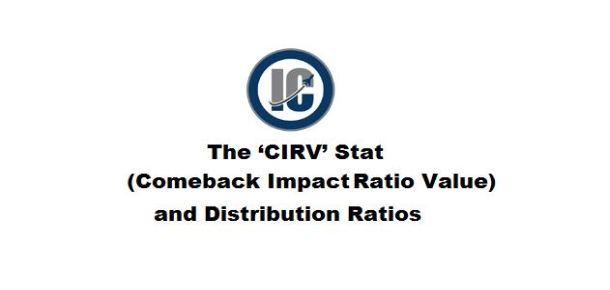Over the years, Illegal Curve Hockey has enjoyed many firsts.
We started out as a blog back in 2007, evolved into a website the next year, started a podcast while I was studying Journalism at Red River College and eventually ended up covering the Winnipeg Jets on TSN 1290 Radio.
Along the way, we have had our own sandwich named after us at Myer’s Deli, we have released the Illegal Curve 59Fifty Baseball Hat and we have broadcasted live from Shaw Park and The Winnipeg Free Press Cafe.
Why would we stop now?
Without further ado (as Drew would say), it is my honour to introduce to you a new first: our very own Illegal Curve Statistic- The CIRV (Comeback Impact Ratio Value).

First, some background.
At the beginning of last season, my father John Ginsburg (a Math Professor at the University of Winnipeg for 32 years, now retired) was discussing who he thought would have the most goals and points for the Winnipeg Jets in the upcoming season. He then began discussing whether or not a statistic existed that measured the impact a goal/assist/point had on a game.
For example. Evander Kane scored 30 goals and 27 assists last season but what do those 30 goals and 27 assists mean as far as having an impact on a game? The reason why this is so important is because when a player scores a goal is undeniably more important than the goal itself. For further proof, one must only look at what has happened recently with 40-year-old designated hitter Raul Ibanez of the New York Yankees. Ibanez has 19 homers this season, 10 of which have tied the game or put or his team in the lead. Now that’s impact.
Lets me first explain the CIRV Statistic and the other distribution ratios. A distribution value refers to the distribution of a player’s goals, assists and points based on the three different stages of a game: when your team is ahead, when your team is tied and when your team is behind. The CIRV or “Comback Impact Ratio Value” is specifically what percentage of a player’s points occur when his team was behind.
In addition to the CIRV Stat, there are five other distribution values: Behind-Goals Ratio, The Behind-or-Tied Goals Ratio, The Go-Ahead-Goals Ratio and The Stay-Ahead-Goals Ratio.
Now, because calculating this stat has not been done before (or at least it has not been released before), it required a significant amount of time. Because of that, data was only collected for 115 players. Below you will find data for four teams (Winnipeg, Toronto, Edmonton, Washington) as well as some of the top offensive producers in the NHL- Sidney Crosby, Evgeni Malkin, James Neal, Claude Giroux, Daniel Briere, Scott Hartnell, Steven Stamkos, Martin St.Louis and Vincent Lecavalier).
Notes:
1. All players on four teams are included; Winnipeg, Washington, Toronto, Edmonton, as well as Malkin, Neal, Giroux, Hartnell, Briere, Stamkos, St Louis, Lecavalier.
2. Among all the players listed in this file, a total of 1154 goals were scored: of these, 400 were scored when the team was trailing, 372 when the score was tied and 382 when the team was ahead.
– Players are shown ranked by total points.
– The ”behind-goals-ratio” for a player is the proportion of his goals that were scored when his team was losing at the time. For example, if a player scored 25 goals in total, and 10 of these were scored when his team was behind, this would be 10/25 = .40
– The ”behind-or-tied-goals-ratio” for a player is the proportion of his goals that were scored when his team was either losing or tied with the opposition at the time. In the previous example, suppose a player scored 25 goals in total, and that 10 of these were scored when his team was behind, and 6 of the goals were scored when his team was tied at the time. Then his behind-or-tied-goals-ratio would be (10+6)/25 = 16/26 = .64
– The ”behind-points-ratio”for a player is the proportion of his total points that were scored when his team was losing at the time. For example, if a player scored 25 goals and 35 assists in total for 60 points, and if 48 of these points were earned when his team was behind at the time, this would be 48/60 = .8
The ‘CIRV‘ – the comeback-impact ratio value: it is a measure of the proportional impact the player’s points have on bringing his team back from a losing situation.
– The ”behind-or-tied-points-ratio”for a player is the proportion of his total points that were scored when his team was either losing or tied at the time. For example if a player scored 40 points and 14 of these were earned when his team was losing, and another 16 of those points were earned when his team was tied, then this ratio would be (14+16)/40 = 30/40 = .75
We will begin by providing the raw data.
(Click here to see a Chart with All Players)
As you can see, of the 115 players tracked, the average CIRV Stat (behind-points-ratio) is 0.34, which means the average player scores 34% of his points when his team is behind at some point in a game. As expected, players on weaker teams tend to have a higher CIRV Stat. Two players who had high CIRV’s were Taylor Hall of the Edmonton Oilers, who had a CIRV of 0.46 last year (24 of his 52 points were scored when his team was behind) and Vincent Lecavalier of the Tampa Bay Lightning who had a CIRV of 0.43 last year (27 of his 49 points were scored when his team was behind).
Now, what is interesting to note is the differences in CIRV stats between players on the same team. For example, take the Washington Capitals, who one would consider a strong team based on the fact they made the Stanley Cup Playoffs last year. Alexander Ovechkin had a CIRV of .22 last year (14 of his 65 points were scored when his team was behind) while Brooks Laich had a CIRV of 0.44 last year (17 of his 39 points were scored when his team was behind). Again, the CIRV stat shows you the percentage of a player’s points which have an impact on bringing his team back into a game.

Looking at the same two players, a different trend emerges when you look at the GAGR (Go Ahead Goals Ratio). Alexander Ovechkin had a GARV of 0.41 (he scored 16 of his 39 goals last season to put his team ahead at some point in a game) whereas Brooks Laich had a GARV of 0.23 (he scored four of his 17 goals last season to put his team ahead at some point in a game). The group average for go-ahead goals ratio is 0.34 or 34%.
To truly measure theses statistics, lets now analyze the distribution of points for the top three point producers in the National Hockey League last season: Evgeni Malkin, Steven Stamkos and Claude Giroux.

What jumps out immediately is that Steven Stamkos has the best GAGR (Go Ahead Goals Ratio) of the three players at 0.36 compared to Claude Giroux at 0.29 and Evgeni Malkin at 0.22. Again, the GAGR mean thats 36% of Stamkos’ goals put his team ahead at any given point in a game in 2011’12. Last season, Stamkos scored 22 of his 61 goals to put his team ahead whereas Claude Giroux scored 8 of his 28 goals (29%) to put his team ahead and Evgeni Malkin scored 11 of his 49 goals (22%) to put his team ahead.
Staying on the GAGR, two of the highest ranked players are Winnipeg Jets. Andrew Ladd registered 13 of his 28 goals (46%) to put his team ahead last year and Bryan Little scored 11 of his 24 goals (46%) to put his team ahead last year. Evander Kane and Blake Wheeler, also of the Jets, both had a GAGR of 41%, which is significantly above the group average of 34%.
Here are some other interesting observations from Illegal Curve’s research:
– Of the 43 players who were tracked that registered over 30 points this season, Jets defenseman Zach Bogosian had the highest CIRV Stat at 0.57. In other words, Bogosian scored 17 of his 30 points when his team was behind. 2nd to Bogosian of the players who had more than 30 points was John Carlson, who had a CIRV of 0.52 (16 of his 31 points were scored when his team was behind. Interestingly, Bogosian’s Behind-Goals-Ratio was 0.8 meaning 4 of his 5 goals were scored when his team was behind.

– Of the top 30 ranked players by points, Daniel Briere of the Philadelphia Flyers had the highest Behind-or-Tied Goals Ratio at 87.5% last season (14 of his 16 goals were scored when his team was either tied or behind).
Note: The average BTGR was 61%
– Of the top 30 ranked players by points, Vincent Lecavalier was ranked second to Briere with a Behind-or-Tied Goals Ratio (BTGR) of 86.3 (19 of his 22 goals were scored when his team was either behind or tied).

– The top two Winnipeg Jets scorers, Blake Wheeler and Evander Kane, both ranked above average when it came to Behind-or-Tied Goals. Blake Wheeler had a BTGR of 0.76 last season (14 of his 17 goals were scored when his team was behind or tied) while Evander Kane had a BTGR of 0.72 last season (22 of his 30 goals were scored when his team was either behind or tied)
– Of the top 30 ranked players by points, Evgeni Malkin has the lowest BTGR at 0.45 (22 of his 49 goals were scored when his team was behind or tied)
– Of the top 30 ranked players by points, Sam Gagner had the second lowest BTGR at 0.56 (10 of his 18 goals were scored when his team was behind or tied). Tyler Bozak of the Toronto Maple Leafs also had a BTGR of 0.56 (10 of his 18 goals were scored when his team was behind or tied).

In conclusion, we have seen that the distribution of goal/point ratios can be very revealing and can provided added value to any given player’s regular point totals. It must be noted again however that because we don’t have statistics for every player in the NHL for last season or any other season it is difficult to form a complete analysis with complete conclusions. By introducing these statistics, we are hoping to stir a healthy debate and provide a framework to perform a more detailed analysis in the future.
To see a team-by-team breakdown, please click here;
Special Note: A very big thank you to John Ginsburg who calculated and prepared all the statistics for this article. This article would not have been possible without his efforts.
For Illegal Curve, I’m Ezra Ginsburg.




